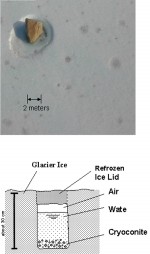Life in Extreme Environments at McMurdo Dry Valleys LTER
Andrew G. Fountain, MCM-LTER
Additional Investigators, Dorota Poransinka, Martyn Tranter, and Christine Forman
Frozen environments comprise 25% of the Earth’s surface. Once believed to be devoid of life, closer observations of glacial ice reveals microhabitats—frequently teeming with life. Cryoconite holes, from “cryo” meaning ice and “conite” meaning dust, form on glaciers in the McMurdo Dry Valleys and offer a unique addition to the growing list of extreme habitats where life thrives.
New research on these micro habitats suggests they are more important to the overall function of the polar desert ecosystem than previously thought.
Cryoconite holes develop from sediment that collects in small patches on the glacier surface (Fig. 1-top). As the hole grows, fine sediments, microorganisms and organic matter collect, creating an ideal environment for cold-weather critters.
Open, water-filled cryoconite holes are commonly found on the exposed surfaces of glaciers in temperate alpine regions. These holes frequently contain biota, including microfauna such as tardigrades, rotifers, protozoans, copepods, insect larvae and cyanobacteria. In contrast to these open holes, cryoconite holes on the glaciers of the McMurdo Dry Valleys are covered with an ice lid of up to 30 cm thick (Fig. 1-bottom). This lid isolates the hole from the atmosphere and the surrounding glacier surface. Analysis of the chloride content of the hole melt waters, in comparison to the surrounding ice, suggests that the melt waters are often isolated from the atmosphere for a year or more. As a result, solutes accumulate over time; atmospheric gases such as N2, O2, and CO2 are scavenged from ice bubbles resulting in chemistries within the cryoconite holes that are distinct from the surrounding ice. The photosynthetic and heterotrophic activity of resident organisms modify the initial geochemical characteristics of the cryoconite dust. Algae and cyanobacteria have been identified in cryoconite holes of the McMurdo Dry Valleys, as well as rotifers and tardigrades. Our estimates of bacterial production in the cryoconite sediment rival that of the local lake water.
Cryoconite holes cover about 7% of the ice-covered zone of our study glaciers with diameters from 1 cm to meters and averaging about 38 cm. The ice lids average about 14 cm thick over a 14 cm water column. Cryoconite holes are frozen solid for most of the year, except for a few summer months when solar radiation melts the ice around the sediment allowing biological activity to occur within this sealed microcosm. The contents of the holes are flushed during decadal warming events, when melt water abounds on the glacier surface. The flushing events transport the hole contents to the valley streams and eventually to the lakes, thereby providing organic carbon and other nutrients to oligotrophic aquatic ecosystems downstream. Nutrients make their way back up to the cryoconite holes via dust, and various chemical cycles. This feedback loop connects all the major components of the dry valley ecosystem and involves exchanges of unique biogeochemistries between soils, streams, lakes and glaciers.
We have encountered holes that have been isolated by an ice lid from the atmosphere for a decade. For such holes we believe that gases and some nutrients important to the biochemical reactions are scavenged from the melting ice. Other nutrients may be obtained from the dissolution of both inorganic and organic debris in the hole. Photosynthesis, which only occurs during summer, utilizes both new and recycled nutrients and drives the pH, O2-saturation and pCO2 towards values of 11, 160% and 10-7 atms, respectively. This chemistry better resembles that of African soda lakes than glacial melt waters. We speculate that photosynthesis may be limited by this combination of extreme values.
Cryoconite holes contribute to the functioning of the polar desert ecosystem by playing an important role in recycling nutrients, biota, and sediments in a system seemingly lacking linkages between ecosystem components. The formation of the cryoconite holes, partly through biologic activity, may initiate conditions for melt that are critical to the entire polar desert ecosystem in the dry valley. This work has significant ramifications across multiple scales. We are exploring icy extremes that support antarctic life, as well as contributing to the understanding of the global-glaciation theory of our planet. Cryoconite holes provide a modern day analog of a possible refuge for microbial life during Snowball Earth. In addition, our study sets the stage for future searches for life on other ice-bound planets and moons such as Mars and Europa.
Relevant Literature
Gribbon, P. W. 1979. Cryoconite holes on Sermikaysak, West Greenland. Journal of Glaciology, 22, 177-181.
Mueller, D. R., W. F. Vincent, W. H. Pollard and C. H. Fritsen. 2001. Glacial cryoconite ecosystems: a bipolar comparison of algal communities and habitats. Nova Hedwigia, 123, 171-195.
Wharton, R. A., Jr., C. P. McKay, G. M. Simmons, Jr. and B. C. Parker. 1985. Cryoconite holes on glaciers. Bioscience, 35, 499-503.

 Enlarge this image
Enlarge this image